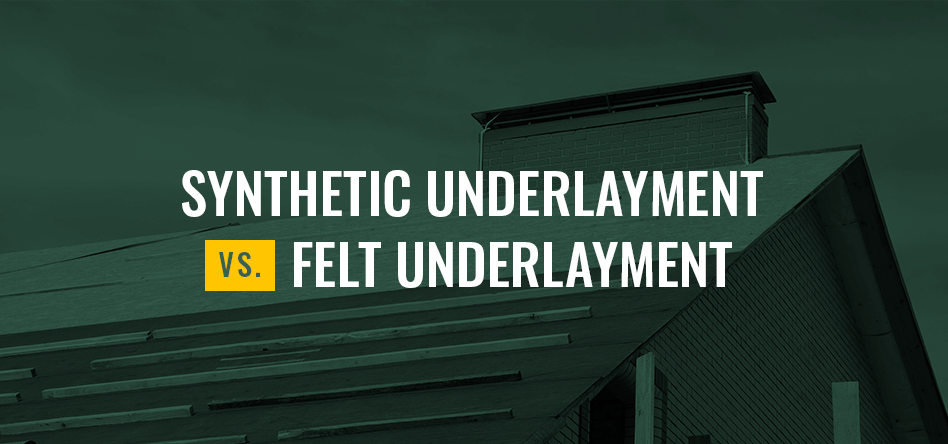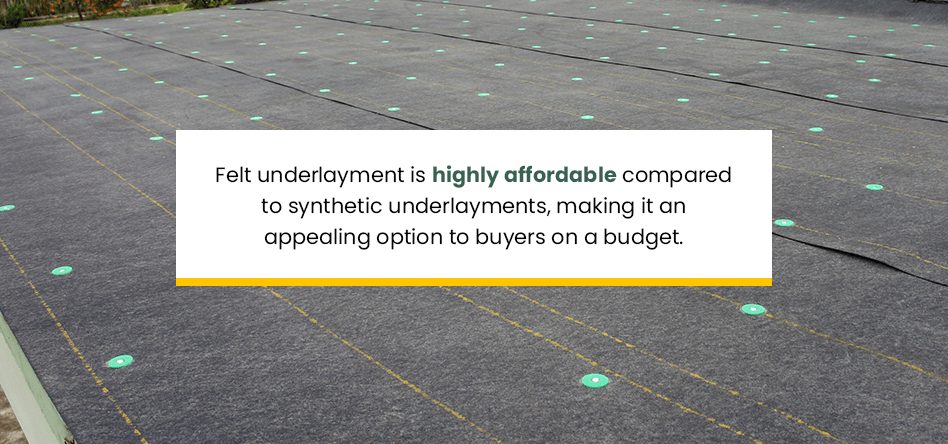Synthetic Underlayment vs. Felt Underlayment

Your roof is one of the most critical parts of your home. All year long, it helps you and your family stay safe from whatever the weather can throw at it. From dirt and debris carried by the wind to torrential rains and heavy snow, your roof keeps the inside of your home safe and dry. But do you ever stop to consider your roof underlayment?
Roofing underlayment is the layer between your roof deck and your shingles or other roofing material. Its main advantage is that it protects the wooden roof deck from moisture damage by repelling water. Whether you’re building a new home or repairing an existing roof, the type of roofing underlayment you choose matters. You have two main options — synthetic underlayment and felt underlayment.
Synthetic Underlayment Pros and Cons
Synthetic underlayment has been around for a few decades and consists of long-lasting polymers that offer strength and longevity for your roof’s protection. Most synthetic underlayments use polypropylene or polyethylene in their construction, incorporating different thicknesses for specific applications. The most common metric to use when comparing synthetic underlayments is grams per square meter.
Different manufacturers will make slightly different synthetic underlayment products. If you’re considering synthetic underlayment for your roof, take some time to compare different brands. Manufacturers will fine-tune their synthetic underlayment to provide different characteristics like enhanced walkability or increased exposure time.
Here’s a list of some of the main pros of synthetic underlayment:
- Durability: Synthetic underlayment is highly tear-resistant and can withstand extended periods of UV and moisture exposure. It can also withstand boot traffic during the installation phase.
- Fast installation time: Choosing synthetic underlayment can contribute to faster turnaround times. Synthetic underlayment is lighter than felt underlayment, which makes maneuvering it at the job site and going up ladders a bit easier. You also get more underlayment per roll for the weight, which helps the roofers stay even more efficient when installing.
- Better Excellent repellency: The materials used in synthetic underlayment have excellent water repellency, which is crucial for homeowners concerned about moisture levels.
- Safe to work on: Because synthetic underlayment has a grippier texture, it’s safer for workers to navigate during the installation phase.
Despite the many positive characteristics of synthetic underlayments, there are also some potential concerns you should know about:
- High cost: Synthetic underlayment commands a higher cost than felt underlayment. In other words, you’re paying for quality.
- Less permeable: Synthetic products have a lower perm rating than felt. Perm rating refers to how much moisture from the attic can escape through the roofing underlayment. Proper attic ventilation is important when using synthetic underlayment for this reason.
Felt Underlayment Pros and Cons
People have been using felt roofing underlayment for hundreds of years. Making it involves saturating fiberglass or paper with asphalt, creating a form of asphalt-saturated felt. The result is a roll of felt that repels water and provides tried-and-true roof protection.
Here are some of the main positive aspects of felt underlayment:

- Affordability: Felt underlayment is highly affordable compared to synthetic underlayments, making it an appealing option to buyers on a budget.
- Simple decision process: There are only two main types of felt underlayment — No. 15 and No. 30, which are thinner and thicker versions, respectively. This makes it easy to choose the right type for your application, as opposed to choosing from the many synthetic underlayment options.
- Higher perm rating: Moisture permeability from the attic is key to keeping your home in good condition. Felt underlayment has a better perm rating than synthetic underlayment, so it’s ideal for homeowners concerned about moisture in their attic.
- Satisfactory results when installed properly: When installed properly, felt underlayment can provide excellent roof protection results for years to come.
Ensure you understand the following cons of felt underlayment before making your decision:
- Lower durability: Felt underlayment has lower durability than synthetic underlayment. It’s prone to tearing and can wrinkle if it absorbs water after prolonged exposure. These issues can lead to damage to your roof and shingles that don’t lie flat. For this reason, it’s paramount that you have your shingles installed as soon as possible after the underlayment goes down.
- Difficult handling and work process: Felt underlayment is challenging to handle because of its heavier weight and roll size. It’s also more slippery to walk and work on, making it less safe than synthetic underlayment.
Which One Should You Choose?
Now that you know more about the two main types of roofing underlayment, you need to decide which is suitable for your needs. Here are some factors to consider that can help you make the right decision:
- Your budget: Your budget will ultimately determine which option you choose for your roofing underlayment. If you have the money to spare, then you may find the benefits of synthetic underlayment worth the higher cost. If you need to make room in your budget for other things, then felt underlayment could be the best choice for you.
- Your area’s climate: The moisture levels in your area will impact the longevity of your roof underlayment. Homeowners in areas with high moisture and heavy rainfall may want synthetic underlayment for its increased water resistance. Dryer areas may be more suited to get the most out of felt underlayment.
- Pauses in the process: Do you expect there to be any project pauses after laying down your roofing underlayment? Pauses can leave underlayment susceptible to the elements and damage it. If you think you might have to leave the underlayment exposed for a prolonged period, synthetic underlayment is a must.
- Your attic ventilation: Attics with good ventilation have roofs that are better suited for synthetic underlayment. If your attic’s ventilation has room for improvement, you may want to choose felt underlayment because of its higher perm rating.
Total Roofing and Construction Services and Roofing Types
Total Roofing and Construction offers high-quality residential roof replacement services for homeowners in Illinois and Indiana. Our roofing services include asphalt shingle roof replacement, architectural roofing shingle services and metal roofing installation. Whatever type of residential services you need, we can help you determine whether you should choose synthetic or felt underlayment. After you’ve decided, we will strive to find the right solution for you that offers the best quality at a price you can afford.
We know that many questions could arise as you consider the needs of your roof. Homes built in the 1990s are starting to hit that point in their life cycle when roof repairs are necessary, and we want to take the guesswork out of the process for you. Our team of professionals is ready to help you every step of the way so you can feel confident about your roofing project and know that it will be in great shape for years to come.

Contact Us for a Free Quote
Still have questions? Head over to our residential roofing FAQ page to find some answers to the most commonly asked questions we receive. If you’re ready to take the next step toward giving your roof the care it deserves, then request a quote online today.

